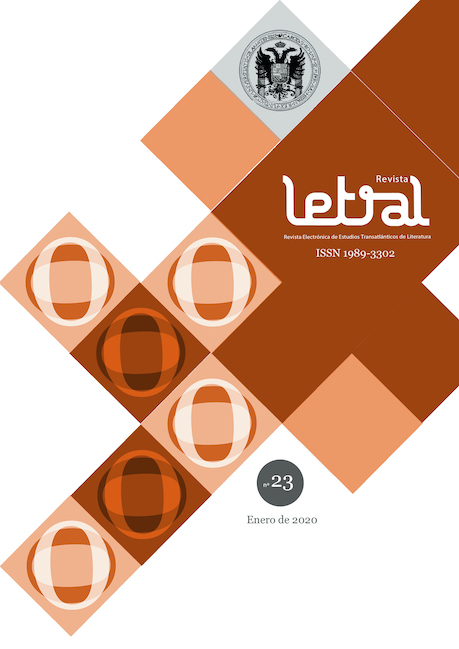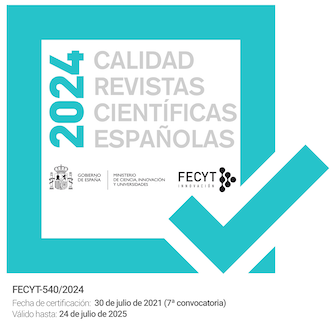Between the Diary and the Cookbook: The Defense of Intimate Writing in Laura Esquivel’s Culinary Trilogy
DOI:
https://doi.org/10.30827/rl.v0i23.9281Keywords:
Personal diary, individualism, privacy, Juana Manuela Gorriti, Laura Esquivel, modernity, cookbook.Abstract
What occurs when a novel is disguised as both a personal diary and a cookbook, two apparently dissimilar genres? The present article attempts to answer that question through an analysis of the culinary trilogy by Mexican author Laura Esquivel: Como agua para chocolate (1989), El diario de Tita (2016), and Mi negro pasado (2017). Several definitions of the personal diary and of privacy as a historical phenomenon shed light upon the functions of diary-writing that El diario de Tita imitates. I contrast the diary’s intimate space with the kitchen’s private space in the first two novels. Although both spaces can be transgressive in their own manner, the diary gives its writer the freedom to reflect and to define him/herself. To delve into the contrast between diary-writing and recipe-writing, I turn to one of the Latin American prototypes of the cookbook mixed with narrative: Cocina ecléctica (1890) by the Argentinian writer Juana Manuela Gorriti. Lastly, I analyze the absence of intimate writing in Mi negro pasado to support the argument that the trilogy defends the right to privacy and reclaims a space for intimate writing within the private space of the family and the public space of society.
Downloads
References
Bibliografía citada
Alberca, Manuel. La escritura invisible. Testimonios sobre el diario íntimo.
España, SENDOA, 2000.
Aranguren, José Luis. “El ámbito de la intimidad”. Castilla del Pino, editor, pp. 17-24.
Béjar, Helena. “Individualismo, privacidad e intimidad: precisiones y andaduras”. Castilla del Pino, editor, pp. 33-57.
Cárdenas Moreno, Mónica. “Índice onomástico: ¿Quiénes fueron las cocineras?”. Cocina ecléctica. 1890. Juana Manuela Gorriti, Buenos Aires, La Crujía Ediciones, 2014, pp. 267-311.
Carreño, Manuel Antonio. Compendio del manual de urbanidad y buenas
maneras. Deberes morales del hombre. Nueva York, D. Appleton y
Compañía, 1860.
Castilla del Pino, Carlos, editor. De la intimidad. Barcelona, Editorial Crítica, 1989.
Cattarulla, Camilla. “Un recetario transnacional”. Cocina ecléctica. 1890. Juana Manuela Gorriti, Buenos Aires, La Crujía Ediciones, 2014, pp.17-33.
Del Águila, Rocío. “Cocinando la nación: Representaciones del capital cultural en Cocina ecléctica”. Diálogo, 18,1, primavera, 2015, pp. 67-78.
Didier, Béatrice. Le journal intime. París, Presses Universitaires de France, 1976.
Esquivel, Laura. Como agua para chocolate. Novela de entregas mensuales con recetas, amores y remedios caseros. México, Colección Fábula, 1989.
---. El diario de Tita. 2015. Barcelona, Penguin Random House Grupo Editorial,2016.
---. Íntimas suculencias: tratado filosófico de cocina. 1998. Barcelona, Random House, 2007.
---. Mi negro pasado. México, Penguin Randon House Grupo Editorial, 2017.
Estrade, Christian. “El diario de Witold Gombrowicz como dispositivo literario”. Diarios latinoamericanos del siglo XX. Ana Gallego Cuiñas, Christian Estrade y Fatiha Idmhand, editores, Bruselas, P.I.E. PETER LANG, 2016. pp. 95-107.
Gallego Cuiñas, Ana; Christian Estrade y Fatiha Idmhand, editores. Diarios latinoamericanos del siglo XX. Bruselas, P.I.E. PETER LANG, 2016.
González Stephan, Beatriz. “Escritura y modernización: La domesticación de la barbarie”. Revista Iberoamericana, 60, enero-junio, 1994. pp. 109-124.
Gorriti, Juana Manuela. Cocina ecléctica. 1890. Camila Cattarulla, editora.
Argentina, La Crujía Ediciones, 2014.
---. Cocina ecléctica. 1890. Obras completas. Tomo III. Alicia Martorell, editora. Argentina, Fundación del Banco del Noroeste Coop. Ltdo, 1992, pp.151-349.
Puértolas, Soledad. “Literatura de la intimidad”. Carlos Castilla del Pino, editor. 119-149.
Ibsen Kristine. “On Recipes, Reading, and Revolution: Postboom Parody in Como agua para chocolate”. Hispanic Review, vol. 63, issue 2, primavera, 1995, DOI 10.2307/474551. EBSCO host. Accedido el 7 de marzo de 2019.
Oropesa, Salvador A. “Como agua para chocolate de Laura Esquivel como lectura del Manual de urbanidad y buenas costumbres de Manuel Antonio
Carreño”. Monographic Review, 8 1992, pp. 252-260.
Ortiz, Cristina. “Como agua para chocolate: Manera de hacerse”. Letras
Femeninas, vol. 22, núm. 1/2, primavera-otoño, 1996, pp. 121-130.
Pilcher, Jeffrey. “Recipes for Patria: Cuisine, Gender, and Nation in Nineteenth Century Mexico.” Recipes for Reading: Community Cookbooks, Stories, Histories. Anne Bower, Massachusetts, University of Massachusetts Press,1997, pp. 200-215.
Salkjelsvik, Kari. “El desvío como norma: la retórica de la receta en Como agua para chocolate”. Revista Iberoamericana, vol. XLVI, núm. 186, enero-marzo, 1999, pp. 171-182.
Simonet-Tenant, Françoise. Le journal intime. Genre littéraire et écriture
ordinaire. Paris, Téraèdre, 2004.
Zubiaurre, Maite. “Culinary Eros in Contemporary Hispanic Female Fiction: From Kitchen Tales to Table Narratives.” College Literature, 33, 3, 2006, pp. 29-51.
Downloads
Published
How to Cite
Issue
Section
License
Revista Letral is an open access journal under a Creative Commons Atribución-NoComercial 4.0 license.
The works published in this journal may be reused, distributed and publicly presented for non-commercial purposes, provided that: cite the authorship and the original source of the publication (journal, publisher and URL of the work).
We strongly recommended you to share our published articles in social and scientific networks, institutional and public repositories, personal or institutional websites, blogs, Google Scholar, ORCID, ResearchID, ScopusID, etc.
The journal allow the author(s) to hold the copyright and to retain publishing rights without restrictions.
We are completely free, both for readers and authors.















